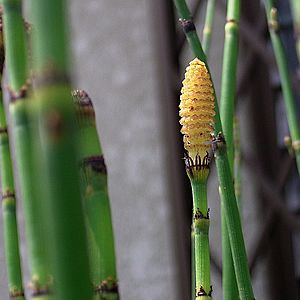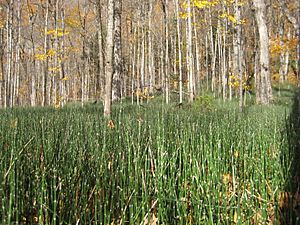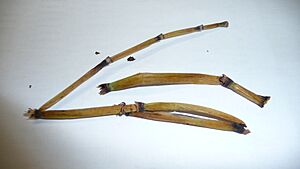Equisetum hyemale facts for kids
Quick facts for kids Equisetum hyemale |
|
|---|---|
 |
|
| Conservation status | |
| Scientific classification | |
| Genus: |
Equisetum
|
| Species: |
hyemale
|
| Synonyms | |
|
Hippochaete hyemalis (L.) Bruhin |
|
Equisetum hyemale is a cool plant known by many names, like rough horsetail or scouring rush. In South Africa, some people even call it snake grass. It's a type of plant that lives for many years (a perennial herb). It belongs to the horsetail family, Equisetaceae. This plant is found naturally across a huge area called the Holarctic Kingdom. You can spot it in North America, Europe, and northern Asia.
Contents
Where Does Rough Horsetail Grow?
Equisetum hyemale loves places that are reliably moist, often with sand or gravel. It can grow from sea level all the way up to about 2,530 meters (8,300 feet) high!
You'll mostly find it in wetlands, which are areas like marshes or swamps. It also grows along rivers and streams, where it can handle floods. Sometimes, it pops up near springs and seeps, showing that water is nearby even if you can't see it flowing. Other spots where it thrives include moist forests, lake shores, ditches, and marshes.
What Does Rough Horsetail Look Like?
Equisetum hyemale has tall, straight stems that look like reeds. They are usually medium to dark green. These hollow stems can grow up to 3 feet (about 1 meter) tall. They don't usually have many branches.
The stems have clear ridges that feel rough. This is because they contain a lot of a hard substance called silica. Imagine tiny bits of glass in the plant!
The plant's tiny leaves are joined together around the stem. They form a thin, dark band at each joint. Like ferns, this plant doesn't make flowers or seeds. Instead, it reproduces using tiny spores.
In cold places, the stems usually die back in winter. But in warmer areas, they can stay green all year. This plant often grows in dense groups, spreading out in sunny or partly sunny spots.
Different Types of Rough Horsetail
There are a few different kinds of Equisetum hyemale.
- Equisetum hyemale subsp. affine is a type found only in North America.
You might also see plants sold as Equisetum japonicum (barred horsetail) or Equisetum camtschatcense (Kamchatka horsetail). These are actually just different forms of E. hyemale.
How People Use Rough Horsetail
This plant has been used for many different things throughout history!
Cleaning and Polishing
Because its stems are so rough, people have used Equisetum hyemale to scrub pots. It's like a natural sandpaper!
In Japan, people boil and dry Equisetum hyemale stems. They then use them as a traditional polishing material, much like fine sandpaper.
Making Music
The dried stems are also used to shape the reeds for musical instruments. These include reed instruments like clarinets and saxophones.
Traditional Medicine
Some Plateau Indian tribes used to boil the stalks. They would drink the liquid as a diuretic, which helps the body get rid of extra water.
It is also used as a homeopathic remedy.
Growing Rough Horsetail in Gardens
Equisetum hyemale is grown as an ornamental plant in gardens. It's popular in modern and Asian-style gardens because of its tall, straight look. It fits well in narrow spaces, like between paths and walls, or on small balconies.
It's also used as a decorative plant in garden ponds and other water features. Gardeners often plant it in pots that are placed underwater.
Sometimes, this plant is sold as "barred horsetail" or "Equisetum japonicum". But it looks different from another plant called Equisetum ramosissimum var. Japonicum.
Is it Invasive?
This plant can spread very quickly underground. Its roots can even go under pavements and garden walls! To keep it from spreading too much, gardeners often use root barriers or large pots sunk into the ground.
In South Africa and Australia, Equisetum hyemale is considered an invasive species. This means it can take over moist natural areas and harm local plants.
See also
 In Spanish: Equiseto de invierno para niños
In Spanish: Equiseto de invierno para niños





